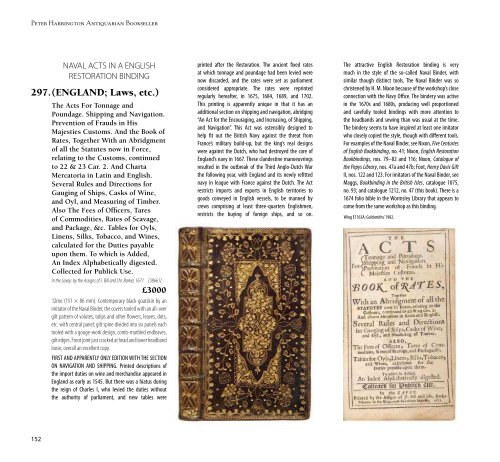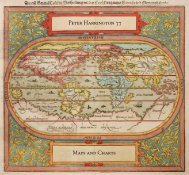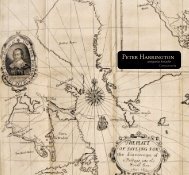antiquarian bookseller - Peter Harrington
antiquarian bookseller - Peter Harrington
antiquarian bookseller - Peter Harrington
You also want an ePaper? Increase the reach of your titles
YUMPU automatically turns print PDFs into web optimized ePapers that Google loves.
<strong>Peter</strong> <strong>Harrington</strong> Antiquarian Bookseller<br />
NAVAL ACTS IN A ENGLISH<br />
RESTORATION BINDING<br />
297.(ENGLAND; Laws, etc.)<br />
The Acts For Tonnage and<br />
Poundage. Shipping and Navigation.<br />
Prevention of Frauds in His<br />
Majesties Customs. And the Book of<br />
Rates, Together With an Abridgment<br />
of all the Statutes now in Force,<br />
relating to the Customs, continued<br />
to 22 & 23 Car. 2. And Charta<br />
Mercatoria in Latin and English.<br />
Several Rules and Directions for<br />
Gauging of Ships, Casks of Wine,<br />
and Oyl, and Measuring of Timber.<br />
Also The Fees of Officers, Tares<br />
of Commodities, Rates of Scavage,<br />
and Package, &c. Tables for Oyls,<br />
Linens, Silks, Tobacco, and Wines,<br />
calculated for the Duties payable<br />
upon them. To which is Added,<br />
An Index Alphabetically digested.<br />
Collected for Publick Use.<br />
In the Savoy: by the Assigns of J. Bill and Chr. Barker, 1671 [38661]<br />
£3000<br />
12mo (151 × 86 mm). Contemporary black goatskin by an<br />
imitator of the Naval Binder, the covers tooled with an all-over<br />
gilt pattern of volutes, tulips and other flowers, leaves, dots,<br />
etc. with central panel; gilt spine divided into six panels each<br />
tooled with a gouge-work design, comb-marbled endleaves,<br />
gilt edges. Front joint just cracked at head and lower headband<br />
loose, overall an excellent copy.<br />
FIRST AND APPARENTLY ONLY EDITION WITH THE SECTION<br />
ON NAVIGATION AND SHIPPING. Printed descriptions of<br />
the import duties on wine and merchandise appeared in<br />
England as early as 1545. But there was a hiatus during<br />
the reign of Charles I, who levied the duties without<br />
the authority of parliament, and new tables were<br />
printed after the Restoration. The ancient fixed rates<br />
at which tonnage and poundage had been levied were<br />
now discarded, and the rates were set as parliament<br />
considered appropriate. The rates were reprinted<br />
regularly hereafter, in 1675, 1684, 1689, and 1702.<br />
This printing is apparently unique in that it has an<br />
additional section on shipping and navigation, abridging<br />
“An Act for the Encouraging, and Increasing, of Shipping,<br />
and Navigation”. This Act was ostensibly designed to<br />
help fit out the British Navy against the threat from<br />
France’s military build-up, but the king’s real designs<br />
were against the Dutch, who had destroyed the core of<br />
England’s navy in 1667. These clandestine manoeuvrings<br />
resulted in the outbreak of the Third Anglo-Dutch War<br />
the following year, with England and its newly refitted<br />
navy in league with France against the Dutch. The Act<br />
restricts imports and exports in English territories to<br />
goods conveyed in English vessels, to be manned by<br />
crews comprising at least three-quarters Englishmen,<br />
restricts the buying of foreign ships, and so on.<br />
The attractive English Restoration binding is very<br />
much in the style of the so-called Naval Binder, with<br />
similar though distinct tools. The Naval Binder was so<br />
christened by H. M. Nixon because of the workshop’s close<br />
connection with the Navy Office. The bindery was active<br />
in the 1670s and 1680s, producing well proportioned<br />
and carefully tooled bindings with more attention to<br />
the headbands and sewing than was usual at the time.<br />
The bindery seems to have inspired at least one imitator<br />
who closely copied the style, though with different tools.<br />
For examples of the Naval Binder, see Nixon, Five Centuries<br />
of English Bookbinding, no. 41; Nixon, English Restoration<br />
Bookbindings, nos. 79–82 and 116; Nixon, Catalogue of<br />
the Pepys Library, nos. 47a and 47b; Foot, Henry Davis Gift<br />
II, nos. 122 and 123. For imitators of the Naval Binder, see<br />
Maggs, Bookbinding in the British Isles, catalogue 1075,<br />
no. 93; and catalogue 1212, no. 47 (this book). There is a<br />
1674 folio bible in the Wormsley Library that appears to<br />
come from the same workshop as this binding.<br />
Wing E1163A; Goldsmiths’ 1982.<br />
298.FADEN, William.<br />
Le Petit Neptune Français; or<br />
French Coasting Pilot, for the Coast<br />
of Flanders, Channel, Bay of Biscay,<br />
and Mediterranean. To which is<br />
added, The Coast of Italy from the<br />
River Var to the Orbitello; with the<br />
Gulf of Naples, and the Island of<br />
Corsica…<br />
London, W. Faden, 1793 [37188] £3500<br />
4to. Engraved frontispiece and 42 engraved charts, maps,<br />
plans and diagrams, most of them folding. Some foxing and<br />
browning, but overall a very good copy in contemporary<br />
marbled boards, somewhat rubbed, rebacked to style in<br />
reversed calf, original label laid down.<br />
FIRST EDITION. Attractive and nicely provenanced<br />
copy of Faden’s timely coastal atlas of France. At this<br />
point in his career Faden’s “systematic… acquisition<br />
of the best available maps… [and] contact with mapmakers<br />
throughout Europe” had made his “the most<br />
competent cartographic service of the period… his<br />
activities foreshadowed the emergence of national<br />
cartographic agencies” (ODNB). His publication of an<br />
up-to-date survey of the coastal waters of France in the<br />
year that England declared war against the Revolutionary<br />
government reveals an acuity of commercial<br />
judgement to match his cartographic accuracy.<br />
Provenance: bookplate of [Admiral Sir] George Francis<br />
Seymour to the front pastedown and that of the Library<br />
at Ragley Hall, seat of the Conway-Seymour family and<br />
the Marquesses of Hertford to the front free endpaper.<br />
An inked inscription to the front pastedown shows that<br />
the book was given to Admiral Seymour by his fatherin-law<br />
Admiral Sir George Berkeley, whose ownership<br />
inscription appears on the title page. Berkeley had already<br />
served with distinction at the Battle of Ushant and in<br />
the Second Relief of Gibraltar when war broke out with<br />
France and he was given command of the Marlborough,<br />
74 guns. On the Glorious First of June his was one of six<br />
ships to break the French line, dismasting two ships of line<br />
Catalogue 57: Travel Section 7: Mapping, Navigation and Naval History<br />
causing them to strike, in consequence Berkeley was one<br />
of the captains to receive the Gold Medal for the battle,<br />
the first engagement to be so honoured. From 1795 to<br />
1797 he commanded the Formidable off Brest, Cadiz,<br />
Ireland and the Texel, and in 1799, having advanced to<br />
rear-admiral, he led the squadrons of the Channel Fleet.<br />
He was recalled from a brief retirement in 1804 and<br />
given the North American command, being responsible,<br />
through his order for the attack on the Chesapeake, for<br />
the outbreak of the War of 1812. Despite public, and to<br />
some extent ministerial, approbation of his conduct<br />
Berkeley was summoned back to England but then<br />
appointed commander-in-chief of the coast of Portugal.<br />
It was in this role, his last posting, that he was render<br />
his most important services to the nation, “Directing all<br />
naval support to the Anglo-Portuguese Army… under<br />
Wellington, Berkeley provided remarkable co-operation.<br />
Nearly all the men, horses, weapons, equipment,<br />
money, and provisions required by Wellington arrived in<br />
Berkeley’s ships or in convoys escorted by his ships. The<br />
squadron performed a major role in the French defeat<br />
in Iberia” (ODNB). Of him Wellington said, “I have always<br />
found [him] not only disposed to give us every assistance<br />
in his power, but to anticipate and exceed our wishes in<br />
this way. It is impossible for 2 officers to be on better terms<br />
than we are.” Berkeley retired in 1812 and weighed down<br />
with wounds and deeply troubled by the gout that had<br />
forced his retirement in 1800 he died in 1818. In view of his<br />
services off Ushant and Brest it is interesting to note that<br />
Berkeley has annotated the chart of the Road of Brest with<br />
quite detailed instructions concerning a land-mark at Pte.<br />
Mathieu and has made several other less easily interpreted<br />
markings in the Gullet and Douarne Nez Bay. The “8th<br />
Chart of the Coast of France…” which shows the waters to<br />
the West of Ushant is marked with a number of locations.<br />
His son-in-law, Admiral Seymour, also saw significant<br />
service during the Napoleonic period. He was with Sir<br />
Alexander Cochrane at Santo Domingo, where he was<br />
wounded, and then, as commander of the Kingfisher<br />
sloop, cruised the French coast. It was Seymour who came<br />
to the rescue of Lord Cochrane, Sir Alexander’s nephew,<br />
when Pallas was dismasted in the fight with the Minerve,<br />
and later at the Basque Roads he “made a gallant effort”<br />
in support of Cochrane’s attempt to destroy the French<br />
fleet, and went to so far as to speak in Cochrane’s favour at<br />
Gambier’s court-martial. Despite this he continued to find<br />
favour, being for time William IV’s naval aide-de-camp<br />
and later Master of the Robes, and becoming one of the<br />
lords of the Admiralty.<br />
152 153








